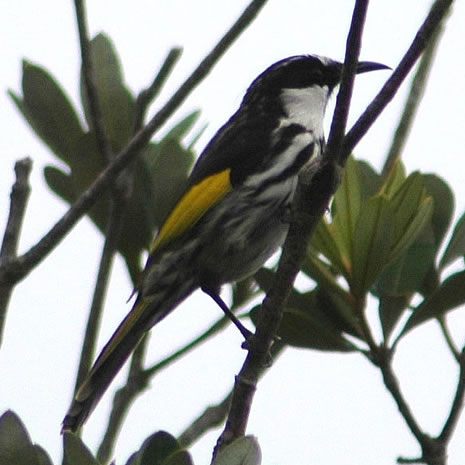�
�

©Atlas of Living Australia: Australian distribution: White-cheeked Honeyeater (Phylidonyris (Phylidonyris) niger)
Phylidonyris (Phylidonyris) niger
White-cheeked Honeyeater
Kingdom
Animalia
Phylum
Chordata
Class
Aves
Order
Passeriformes
Family
Meliphagidae
Genus
Phylidonyris
Species
Phylidonyris (Phylidonyris) niger
Status
least concern
Colours
Distinguishing features
The White-cheeked Honeyeater is a medium-sized black and white honeyeater, with a long, sturdy bill that curves downwards. It has large bright yellow tail and wing panels, with a large conspicuous white cheek patch on a mainly black head. The eye is dark brown. Young birds are duller (brownish) and paler with softer, fluffier plumage. Gregarious, active and noisy with swift, erratic flight (Wikipedia).
Size
- From 16 cm to 19 cm (Length of specimen) - applies to Mature specimens
Weight
- Up to 0.02 kg
Wingspan
- Wingspan data is not yet available.
Synonyms
Similar taxa
-
Animalia:
New Holland Honeyeater (species: Phylidonyris (Phylidonyris) novaehollandiae)
The New Holland Honeyeater is very similar in size, shape and appearance, but can be distinguished by its white eye from the White-cheeked Honeyeater.
Distribution

©Atlas of Living Australia: Australian distribution: White-cheeked Honeyeater (Phylidonyris (Phylidonyris) niger)
Distribution and habitat preferences
The White-cheeked Honeyeater is usually found in moist heath lands, as well as around wetlands and in forests or woodlands with a heath under storey. Found in both temperate and subtropical zones (Wikipedia).

